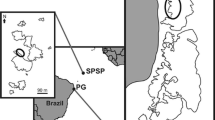Abstract
Distribution and morphology of zooxanthellae were investigated histologically and ultrastructurally in veligers and juveniles of three giant clam species, Tridacna crocea, T. derassa, and T. squamosa. No zooxanthellal cells were associated with gametes. In veliger larvae, zooxanthellae were ingested and digested in the stomach. Within several days after metamorphosis from veliger to a juvenile clam, the zooxanthellal tube, in which zooxanthellae were packed, elongated from the stomach toward the mantle. Zooxanthellae in the tube appeared in a line, and we designated the appearance of the lined zooxanthellae in the mantle of juvenile clams as the first sign of the establishment of symbiosis. The zooxanthellal tubular system developed as the clams grew, particularly in the mantle margin, and then hypertrophied siphonal tissue formed. In zooxanthellal tubes, zooxanthellae usually had intact ultrastructures suggesting that they were photosynthetically active, while the stomach always contained degraded zooxanthellae that were probably discharged from the zooxanthellal tube. Giant clams probably digest zooxanthellae directly, and ingest the secreted photosynthates from zooxanthellae. There may be a selection mechanism to discharge unhealthy zooxanthellae from the mantle into the stomach. In addition to zooxanthellae, digested diatoms and other unidentified digested materials in the stomach suggest that filter-feeding also contributes to giant clam nutrition.




Similar content being viewed by others
References
Carlos AA, Baillie BK, Maruyama T (2000) Diversity of dinoflagellate symbionts (zooxanthellae) in a host individual Mar Ecol Prog Ser 195:93–100
Fankboner PV (1971) Intracellular digestion of symbiotic zooxanthellae by host amoebocytes in giant clams (Bivalvia: Tridacnidae), with a note on the nutritional role of the hypertrophied siphonal epidermis Biol Bull 141:222–234
Farmer MA, Fitt WK, Trench RK (2001) Morphology of the symbiosis between Corculum cardissa (Mollusca: Bivalvia) and Symbiodinium corculorum (Dinophyceae) Biol Bull 200:336–343
Fitt WK, Trench RK (1981) Spawning, development, and aquisition of zooxanthellae by Tridacna squamosa (Mollusca, Bivalvia) Biol Bull 161:213–235
Ishikura M, Adachi K, Maruyama T (1999) Zooxanthellae release glucose in the tissue of a giant clam, Tridacna crocea Mar Biol 133:665–673
Jameson SC (1976) Early life history of the giant clams Tridacna crocea Lamark, Tridacna maxima (Röding), Hippopus hippopus (Linnaeus) Pac Sci 30:219–233
Kawaguti S (1966) Electron microscopy on the mantle of the giant clam with special references to zooxanthellae and iridophores Biol J Okayama Univ 12:81–92
Klumpp DW, Bayne BL, Hawkins AJS (1992) Nutrition of the giant clam Tridacna gigas (L.). I. Contribution of filter feeding and photosyhthate to respiration and growth J Exp Mar Biol Ecol 155:105–122
Klumpp DW, Lucas JS (1994) Nutritional ecology of the giant clams Tridacna teborea and T. derasa from Tonga: influence of light on filter-feeding and photosynthesis Mar Ecol Prog Ser 107:147–156
LaBarbera M (1975) Larval and post larval developments of the giant clams Tridacna maxima and Tridacna squamosa (Bivalvia: Tridacnidae) Malacologia 15:69–79
Mansour K (1946a) Communication between the dorsal edge of the mantle and the stomach of Tridacna Nature 157:844
Mansour K (1946b) Source and fate of the zooxznthellae of the visceral mass of Tridacna elongata Nature 158:130
Maruyama T, Heslinga GA (1997) Fecal discharge of zooxanthellae in the giant clam Tridacna derasa, with reference to their in situ growth rate Mar Biol 127:473–477
Norton JH, Shepherd MA, Long HM, Fitt WK (1992) The zooxanthellal tubular system in the giant clam Biol Bull 183:503–506
Trench RK, Wethey DS, Porter JW (1981) Observation on the symbiosis with zooxanthellae among the Tridacnidae (Mollusca, Bivalvia) Biol Bull 161:180–198
Yonge CM (1936) Mode of life, feeding, digestion and symbiosis with zooxanthellae in the Tridacnidae Sci Rep Gr Barrier Reef Exped (1928–29), Brit Mus (Nat Hist) 1:283–321
Yonge CM (1953) Mantle chambers and water circulation in the Tridacnidae (Mollusca) Proc R Soc Lond 123:551–561
Acknowledgments
The present study was supported by the twenty-first century COE program of the University of the Ryukyus. We are indebted to Dr. Yasunori Saito (Shimoda Marine Research Center, University of Tsukuba) for providing the facilities for electron microscopy and Dr. Hideyuki Yamashiro (Meio University) for his advice on the decalcification of specimens. Dr. James D. Reimer (JAMSTEC) was acknowledged for his valuable comments and correcting the English. This report includes the contribution form Shimoda Marine Research Center (# 713).
Author information
Authors and Affiliations
Corresponding author
Additional information
Communicated by T. Ikeda, Hakodate
Rights and permissions
About this article
Cite this article
Hirose, E., Iwai, K. & Maruyama, T. Establishment of the photosymbiosis in the early ontogeny of three giant clams. Marine Biology 148, 551–558 (2006). https://doi.org/10.1007/s00227-005-0119-x
Received:
Accepted:
Published:
Issue Date:
DOI: https://doi.org/10.1007/s00227-005-0119-x




